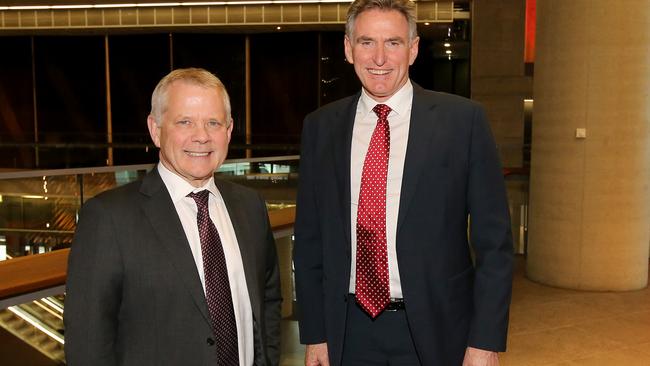Banks turn deeper shade of green

On Tuesday, ANZ Bank chief executive Shayne Elliott privately briefed global investors on the group’s new approach, which was unveiled with the bank’s annual result late last month.
National Australia Bank will provide an update in its sustainability report on Wednesday.
Meanwhile, BlackRock chairman Larry Fink backed up his seminal move to a more forceful climate position at the start of 2020 with a big-picture prediction: that the world is going to see a “seismic reallocation of capital”.
Fink, who manages $US10 trillion ($13.7 trillion) in assets, said there was no question that the “frequency of events is giving us real evidence that climate risk is investment risk”.
BlackRock’s outspokenness on climate change had been good for business, with higher inflows directly linked to the fund using its voice.
Elliott’s slide pack, obtained by Four Pillars, put some hard numbers around Fink’s crystal-ball gazing, saying the transition to a net-zero global economy by 2050 — in line with the Paris Agreement — will require $US1.5 trillion of annual investment in clean energy and efficient infrastructure.
Bank lending, he said, will contribute the lion’s share.
Over in the UK, Bank of England governor Andrew Bailey put the climate challenge in perspective, saying the risks are bigger and more complex to manage than the global pandemic or the financial crisis.
Bailey said British banks and insurers will have to consider whether their capital reserves are equal to the climate risks they face, as part of a stress test for financial institutions which was delayed due to the coronavirus but will now be conducted in June next year.
The Australian Prudential Regulation Authority will undertake a similar project.
Also, as part of efforts to burnish its low-carbon credentials, the UK has outlined plans to launch the country’s first green “gilts”, or government bonds to fund low-carbon infrastructure projects.
The British government, which will host the delayed international climate talks in Glasgow next year, wants to position itself as a leading green finance hub.
Back in Australia, we sit on our hands, refusing to commit a net-zero emissions target by 2050 as more than 70 countries, every state and territory and key business groups sign up. In the meantime, Scott Morrison lamely protests to parliament that he’d like to achieve net-zero emissions “as quickly as possible” but it would be “very deceptive” not to first inform the public about the costs. It’s a straw man’s argument.
There will never be a full assessment of the costs unless there is also consideration of the opportunity cost.
The latter is already significant, and growing.
NAB takes second
National Australia Bank has launched a successful stealth attack on its diminished rivals, inverting the major-bank rankings so that only Commonwealth Bank now lies ahead of it.
Last Monday, in a measure of how far Westpac has fallen, NAB displaced its floundering Sydney rival as the sector’s second most valuable lender, worth $65bn.
By Tuesday NAB had extended that to $70bn over Westpac’s $67.5bn.
NAB’s Docklands neighbour ANZ Bank ($57bn) suffered the same ignominy in July 2019, eight days before NAB announced it had snagged former Royal Bank of Scotland boss Ross McEwan as its new chief executive.
Of course, any stoush between NAB and Commonwealth Bank juggernaut is a no-contest, with CBA’s $128bn market capitalisation exceeding the sum of Westpac and ANZ.
CBA’s long-term ascendancy is assured, and nothing chief executive Matt Comyn says at the first-quarter result on Wednesday will offer a glimmer of hope to his peers.
Morgan Stanley has forecast a 40 per cent rebound in cash profit for recurring businesses to $2.06bn, mainly due to lower loan losses after a $1.5bn overlay in the third quarter of the 2020 financial year.
The franchise is unassailable, performing better than its rivals, with a superior risk profile because of its dominant home-lending business.
The only knock against CBA is that investors are paying too much for a premium stock, currently valued at a 35 per cent premium to its peers.
Unless Comyn pulls hard on the cost lever, joining ANZ’s Elliott in the absolute cost-reduction camp, it’s hard to see CBA shooting the lights out in the face of a low-growth and low-interest rate environment. As for NAB, it remains to be seen if the bank’s climb to number two is an inflection point or a false dawn, because there’s been plenty of the latter over the last two decades.
Since 1998, NAB has reported $20bn in large, one-off items taken below the line — equivalent to 15 per cent of total profit.
McEwan is fond of portraying NAB’s business bank as one of only two leading franchises in the country, the other being CBA’s mortgage business.
Any lasting NAB resurgence depends on its ability to milk the group’s asset, which has defied predictions of a sharp rebound in business credit almost every year since the 2008-09 financial crisis.
If the economy does recover quickly, buoyed by good news overnight on Monday in relation to a COVID-19 vaccine, NAB could benefit from an earnings bounce. It would mark the beginning of the long haul to bridging the CBA valuation gap.
gluyasr@theaustralian.com.au Twitter: @Gluyasr



Important climate-change developments for the financial services industry swept across three continents this week, almost as if carbon neutrality by 2050 is a thing and policymakers ignore it at their peril.